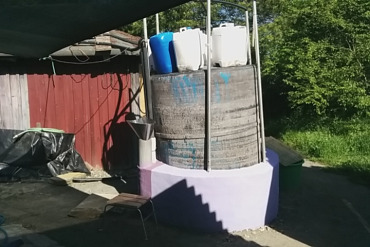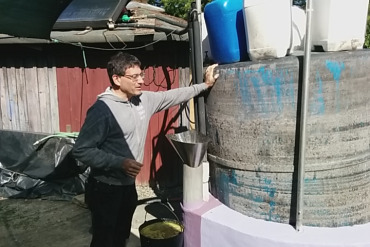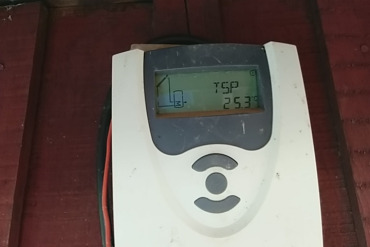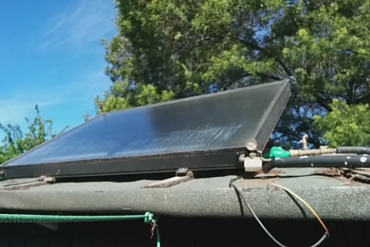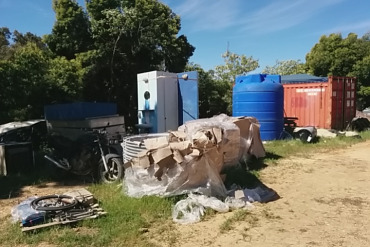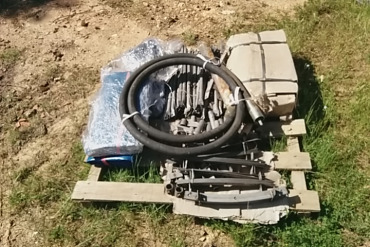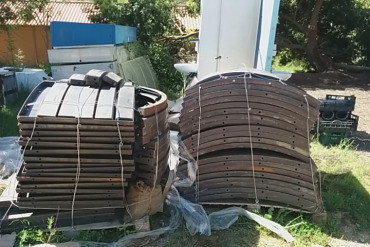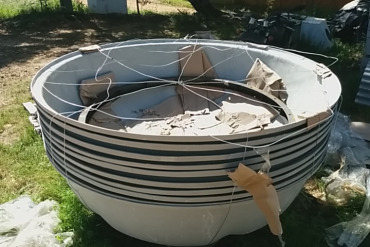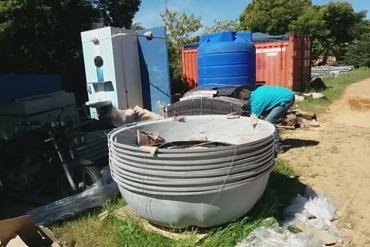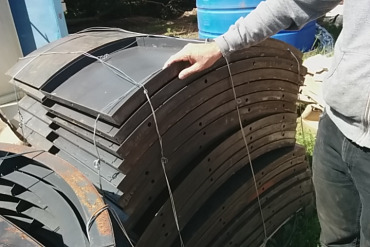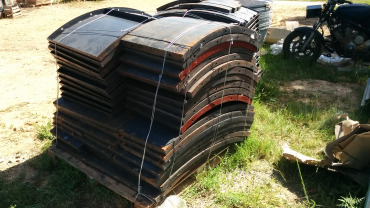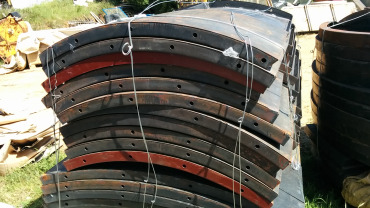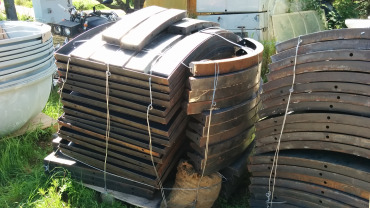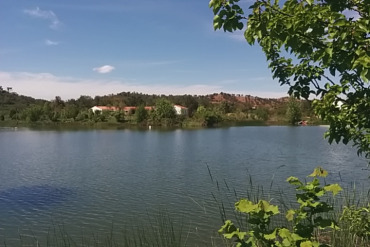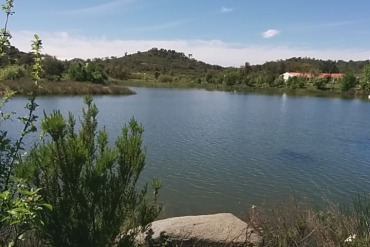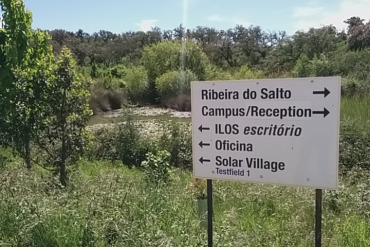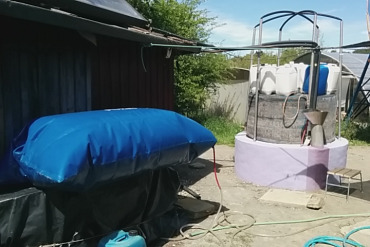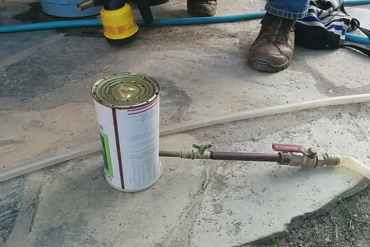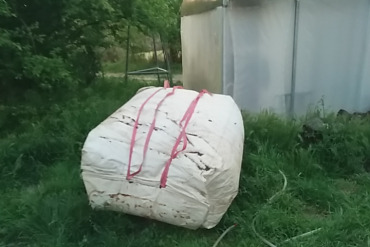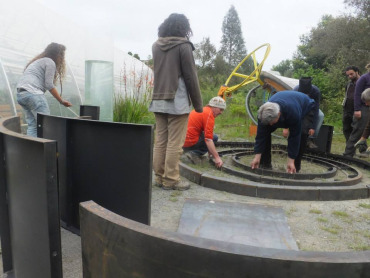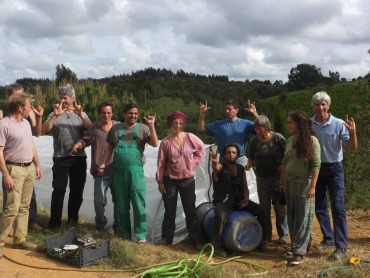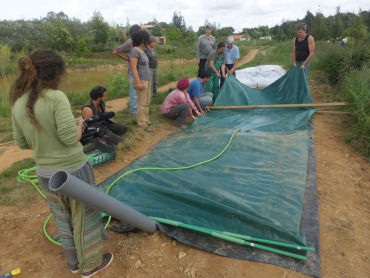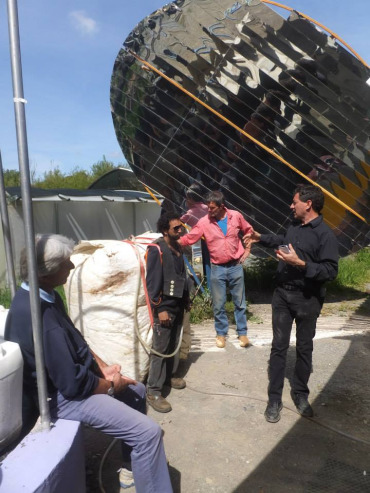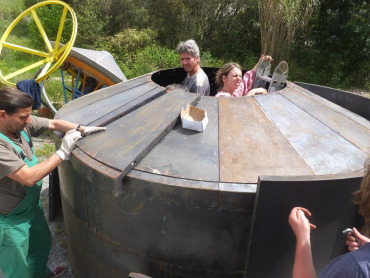This past week T.H. Culhane partnered with Martin Funk and Frederick Weihe and Irma Fäthke at the Tamera Solar Village Test Field to offer the first of what we envision as a continuing series of Solar CITIES comprehensive biogas solutions trainings.
The recent workshop continued work that Culhane had done with the team at Tamera in 2011 when we held a Global Campus workshop to build Tamera's first kitchen-connected Solar CITIES style modified ARTI (Indian floating drum) digester, a delightful living fire breathing dragon now named "Holda". Holda is a 4 cubic meter work-horse (play-dragon) of a biogas system fed on kitchen scraps who (who, not which, since she is alive) has now been in continuous and successful operation for nearly four years, going from a crawling baby to a running toddler.
Young Holda complemented a previously built and much larger fixed dome Chinese style digester up the hill from the kitchen which is connected to a pair of flush toilets and a solar heated shower facility. The fixed dome digester was also modified in 2011 by Culhane and the workshop crew and was in successful operation for some time but has been allowed to rest fallow since Holda is taking care of the kitchen and the inputs and outputs to the toilets and shower have not yet been completed, and because of the labor involved in moving food waste up the hill without a pump. All of these issues are now on a follow up agenda.
The purpose of this month's workshop was to create an even grander "possibility garden" for even greater "possibility management" and train an ever larger number of international participants who can seed their own eco-villages and communities with the biogas solution, which we feel is central to all of permaculture's concentric circles because it connects directly and intimately to the heart and guts of every hearth -- the kitchen and the bathroom. What we hoped to achieve this time was a broad yet detailed view of easy it is to construct a wide variety of effective small scale biogas systems, and provide an opportunity to learn biogas theory through practice, creating a form of biogas praxis that has become the signature of the Solar CITIES initiative.
What has evolved is a rather comprehensive training package that can now be taken on the road from eco-village to eco-village and which can be replicated and multiplied by each new group of trainees so that, through the Global Campus and similar world-wide community participatory development workshops, the clean blue flame and eternal light and fertility of the solar powered biogas solution can rapidlly replace the rampant deforestation and outdoor and indoor air-pollution and water pollution and climate changes associated with biomass and fossil fuels and mined fertilizers.
So what has the Solar CITIES Biogas Workshop evolved into, and how can you recreate it in your community?
The Solar CITIES Workshop has shown that it is possible to build "4 systems in 4 days" and a 5th, larger system, in 5 to 7 days. It works like this:
The "Familiarization with 4 systems in 4 days" approach:
Day 1: Theory and site preparation
9am to 12pm: Basic biogas theory with descriptions of different system types, their applications and uses and technical and social challenges.
1pm to 4pm: Site assessment and materials preparation, cutting pipes and preparing locations.
On this day it becomes clear to participants that "food-waste-to-fuel-and-fertilizer" biodigestion systems can be made rather rapidly out of almost any material that can hold water and whose top can be kept airtight, and that there is a logical sequence to learning how to build one's own biogas system, starting small with the IBCs and the ARTIs and moving on to Sausage systems and then to larger construction with concrete or other heavy and more durable materials.
Day 2: Systems 1and 2 Construction: Small Scale Tank Based Stomach-Simulating Digesters (The Solar CITIES IBC/ARTI Hybrid Solution)
[[{"fid":"1038","view_mode":"content_full","fields":{"format":"content_full","field_file_image_alt_text[und][0][value]":"The Biogas workshop team","field_file_image_title_text[und][0][value]":"The Biogas workshop team","field_folder[und]":"_none"},"type":"media","link_text":null,"attributes":{"alt":"The Biogas workshop team","title":"The Biogas workshop team","height":469,"width":834,"class":"media-element file-content-full"}}]]
9am to 12pm: Hands-on building of a two IBC (International Bulk-Container) based biogas system, one for ground up kitchen waste with 2 inch pipes, another for easy loading with animal manures or other less finely mashed inputs using 4 inch and 3 inch pipes.
1pm to 5pm: Hands-on building of a 1000 or 2000 liter Solar CITIES' modified ARTI system (using two cylindrical water tanks and utilizing "microbial motels" to increase internal surface area).
In our experience, now spanning more than 6 years of building and conducting workshops around the world, the Solar CITIES IBC biodigester is the easiest and most practical DIY (Do-It-Yourself) Build imaginable that can be done entirely with off-she-shelf and usually locally available materials, yielding reliable results and utility. It is possible to find the materials to build such a digester in almost every country in the world out of local materials at a rather low cost. The ARTI style system is also easily built in countries that have relatively inexpensive cylindrical water tanks as long as you can find one tank that fits inside another. Together they make a perfect match, with the IBC functioning as the primary digester and the floating drum functioning as the gasometer/gas holder and as a secondary digester. Where temperatures permit, both the IBC and the ARTI can function as primary digesters with both storing their gas in the same floating drum. When appropriate cylindrical water tanks are not available, a floating gas holder style digester can be built out of garbage cans and oil drums. They won't produce or store as much gas, but can be constructed in series or parallel for greater production and storage and to measure gas output (using them as a gasometer with the floating drum marked with easy to read numbers as it rises and falls.) So the principle is the same regardless and this is the staple of our workshops, ensuring that all participants go home understanding how to create and combine these two simplest of great home biogas systems.
Day 3: System 3 Construction: Small Scale Plastic Bag Intestines-Simulating Digesters (The Flexible Sausage Solution)
[[{"fid":"976","view_mode":"content_full","fields":{"format":"content_full","field_file_image_alt_text[und][0][value]":"Sausage Sytem","field_file_image_title_text[und][0][value]":"","field_folder[und]":"123"},"type":"media","link_text":null,"attributes":{"alt":"Sausage Sytem","height":469,"width":834,"class":"media-element file-content-full"}}]]
9 am to 12 pm: Hands on building of a Flexi-Biogas system "Sausage" digester created by Dominic Wanjahia.
1 pm to 5 pm: Finish filling the systems with microbe innoculants (animal manures, pond muck, effluent from existing digester)
Having visited "salchicha" (sausage) biogas systems in Central America, where they are quite popular, and having participated in the creation of the two plastic bag biogas systems at the Arava Institute in Israel back in 2010, we now feel that Dominick Wanjahia's flexi-biogas system, which we visited in several locations in Kenya and built ourselves in Tamera, is arguably the simplest and most effective of these "intestine" based systems. The great innovations in this system that make it so appropriate for our workshops is that it completely bypasses the usual need to dig and line a trench or build a cinderblock retaining wall, saving hours and hours of labor and high materials costs. The ability to lay the bag flat on the ground is not only a great cost and labor saver but uses the way that gravity pulls on the water in the bag to create pressure for the gas. Pressurizing gas from a normal "salchicha" has been considered a problem in the past, but not in the Flexi-Biogas system from Kenya. Another innovation is the use of simple and widely available 1/2 inch and 3/4 inch polypropylene plumbing pipes to "zip lock" the flexi bag shut, and simple 110 and 160 mm plumbing pipes coupled through slits in the bottom of the bag with just a touch of crazy glue to hold the plastic bag in place as a sleeve when connecting the pipes. All of these innovations make it possible to use a simple tubular piece of PVC tarpaulin as the entire digester and gas holder. Granted for this one you need to obtain the tubular tarpaulin, so it isn't quite as locally accessible a build as the IBCs and ARTIs, but since Flexi-Biogas ships the materials around the world DHL and they only weigh about 23 kilograms you can get them and the provided shade tent fabric in advance of the workhop by post, or do what the Tamera team did and go down to Kenya, help with a build there, buy the materials and bring them back in a suitcase -- no overweight! What could be simpler!
[[{"fid":"1041","view_mode":"content_full","fields":{"format":"content_full","field_file_image_alt_text[und][0][value]":"Assembling the Flexi-biogas system from Kenya","field_file_image_title_text[und][0][value]":"Assembling the Flexi-biogas system from Kenya","field_folder[und]":"123"},"type":"media","attributes":{"alt":"Assembling the Flexi-biogas system from Kenya","title":"Assembling the Flexi-biogas system from Kenya","height":626,"width":834,"class":"media-element file-content-full"},"link_text":null}]]
Day 4:System 4 Construction: Community Scale Concrete Digester Dry Build that can be insulated, with water displacement for gas pressure (The Puxin steel mold based 4, 6 and 10m3 solution).
[[{"fid":"997","view_mode":"content_full","fields":{"format":"content_full","field_file_image_alt_text[und][0][value]":"TH Culhane standing on top of the Puxin moulds","field_file_image_title_text[und][0][value]":"TH Culhane standing on top of the Puxin moulds","field_folder[und]":"123"},"type":"media","link_text":null,"attributes":{"alt":"TH Culhane standing on top of the Puxin moulds","title":"TH Culhane standing on top of the Puxin moulds","height":469,"width":834,"class":"media-element file-content-full"}}]]
9 am to 12 pm: Hands on assembly of the inner and outer body and shoulder molds for the Puxin community scale 10m3 biogas system form.
1 pm to 4 pm: Hands on assembly of the inner and outer neck molds and the 1m3 gas holder and "walkabout" comparison of the costs and benefits and pros and cons of the 4 very different types of systems constructed during the workshop. Often by this day the IBC/ARTI systems are already producing flammable gas if the systems were innoculated with slurry from a previous active build or manures that have been fermented for a few weeks.
This "dry build" of the Puxin system is identical to the training on gets in Shenzhen China at the Puxin company headquarters during their workshops, and is similar to what we have done in the Phillipines, New York, Baghdad, Niteroi and Rio De Janeiro, Brazil and Pennsylvania, New York over the past few years, and which our colleagues at Eco-gas Israel have done throughout their country.
[[{"fid":"1039","view_mode":"content_full","fields":{"format":"content_full","field_file_image_alt_text[und][0][value]":"A \"dry build\" of the Puxin molds","field_file_image_title_text[und][0][value]":"A \"dry build\" of the Puxin molds","field_folder[und]":"123"},"type":"media","attributes":{"alt":"A \\\"dry build" of the Puxin molds","title":"A \\\"dry build" of the Puxin molds","height":626,"width":834,"class":"media-element file-content-full"},"link_text":null}]]
[[{"fid":"1040","view_mode":"content_full","fields":{"format":"content_full","field_file_image_alt_text[und][0][value]":"The sky's the limit with biogas!","field_file_image_title_text[und][0][value]":"The sky's the limit with biogas!","field_folder[und]":"123"},"type":"media","attributes":{"height":626,"width":834,"class":"media-element file-content-full"},"link_text":null}]]
Building the 5th System in 5 to 7 days
If time permits it is also possible to add a finished Puxin 4, 6 or 10m³ system to the mix in the possibility garden during the workshop. This is good for situations where the community has already decided on biogas as a solution and has come to the realization that this "mother of all decentralized solution technologies" is best demonstrated and utilized when there are a variety of builds in one location at a variety of scales and out of a variety of materials.
In this case one can actually start with the pouring of slab on the first day (either below ground if a site has been dug or, as is our preference and recommendation, above ground so the finished digester can be used for vertical aeroponics and hydroponics, for trellising vegetation and wildlife habitat and for education). The second day of the workshop the body molds would be assembled and the concrete poured. The third day of the workshop the neck molds would be assembled and poured. On the fourth day the workshop participants would build the IBC/ARTI digesters. On the 5th day they build the Flexi-biogas system. On the 6th day the inlet and outlet to the Puxin system are created and the three other systems (the ARTI, the IBCs and the Flexi) are filled with manure/innoculant.
On the 7th day, while the Lord is resting, the rest of us remove the molds from the Puxin system and clean them so they can be sent to the next ecovillage or community. The sixth and seventh days technically don't have to be part of the workshop as these completion activities for the systems can be done by the residents who will be using the systems while the workshop participants will have gained sufficient knowledge to be ready for there own builds at home. In this way all systems can be introduced and constructed during a 5 day or 7 day week seminar. Ambitious but certainly doable if materials and sites have all been prepared.

